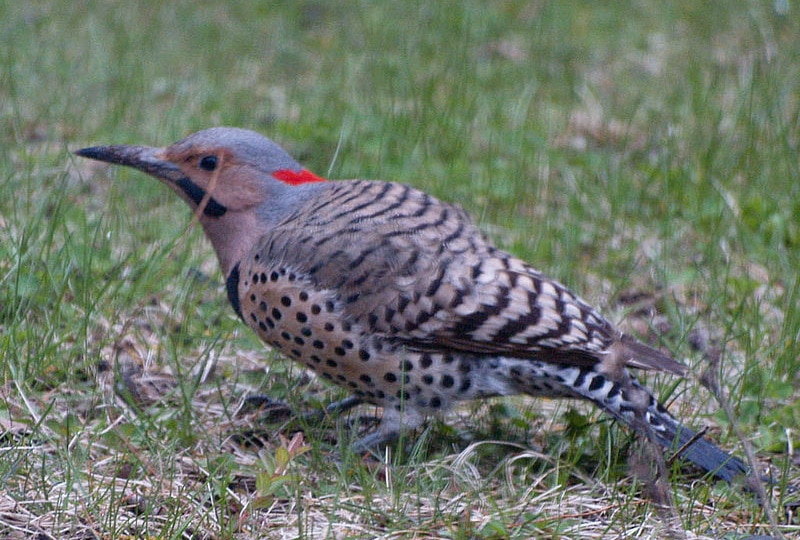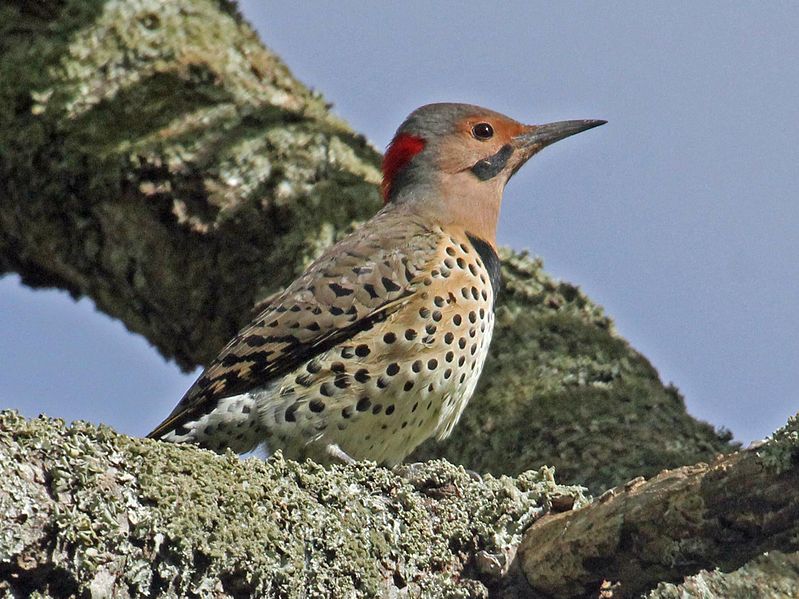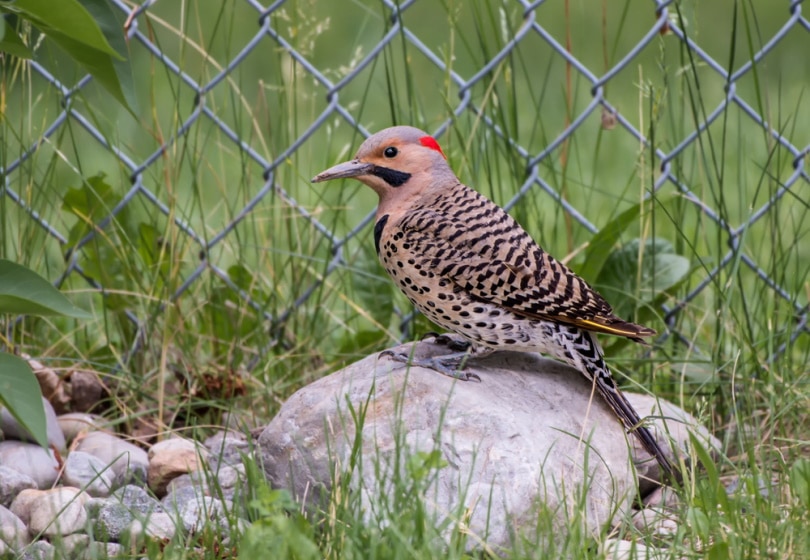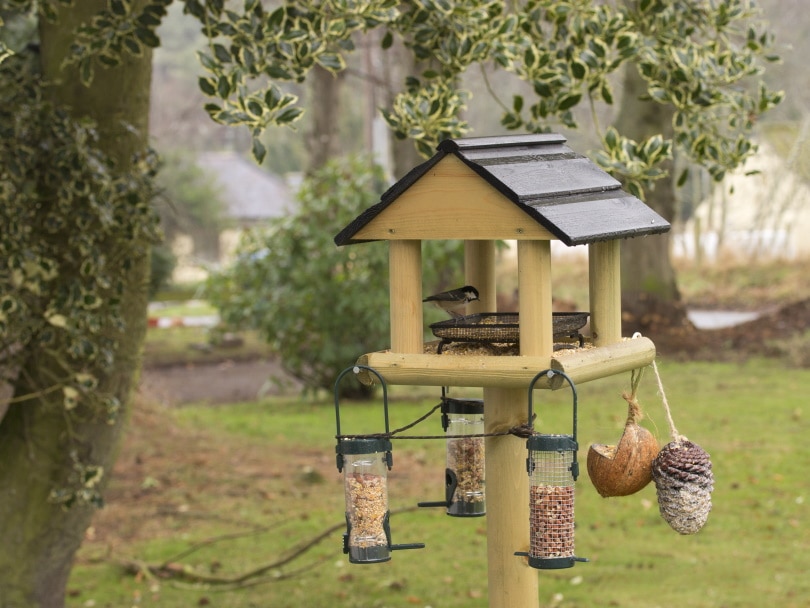Yellow-Shafted Northern Flicker: Field Guide, Pictures, Habitat & Info
Last Updated on

The yellow-shafted northern flicker is a woodpecker that ranges throughout most of North America. This bird gets its name from the yellow feathers on its wings and tail. The male flicker has a red crescent on its chest, while the female does not. These birds are known for their loud calls, which they use to communicate with each other.
If you’re interested in learning more about this incredible bird, read on for some yellow-shafted flicker facts, including information about its habitat, diet, and behavior.

Quick Facts about Yellow-Shafted Northern Flickers
| Habitat | Woodlands, edges, orchards, and backyards |
| Diet | Primarily ants and beetle larvae; also eats fruits, nuts, and seeds |
| Behavior | Active during the day; often seen perching on power lines or fence posts |
| Nesting | Cavities in trees, typically old woodpecker holes |
| Conservation | Least Concern status |
| Scientific name | Colaptes auratus |
| Lifespan: | 6–10 years |
Yellow-Shafted Northern Flicker General Description
The yellow-shafted northern flicker is a member of the woodpecker family. This bird gets its name from the yellow feathers on its wings and tail. The male has a red crescent on its neck, while the female does not. The northern flicker is the only member of the woodpecker family that feeds primarily on the ground.

Yellow-Shafted Northern Flicker: Range, Habitat, Behavior, Diet & Nesting
Range
The yellow-shafted Northern Flicker is a subspecies of the Northern Flicker. It ranges from central Alaska and northern Yukon to Nova Scotia, and south to Baja California, the Gulf States, and northern Florida.
This woodpecker is also found in western Mexico. The nominate race C. a. auratus breeds across most of Canada and the eastern United States; it winters in the southernmost parts of its breeding range.
Habitat
The yellow-shafted northern flicker is found in North America east of the Rocky Mountains. It is a non-migratory bird that typically resides in woodlands but can also be found in parks and gardens.
Behavior
The yellow-shafted northern flicker is a very active bird. It spends most of its time on the ground searching for food. It will also often perch on trees and power lines. As a result, it is one of the easiest birds to spot and identify.

Diet
The yellow-shafted northern flicker primarily eats insects. It will also eat berries, fruits, and nuts. In the winter, when insect populations are low, it will eat more plant material.
Nesting
The yellow-shafted northern flicker nests in tree cavities. It will excavate its own cavity if one is not available. The female lays between 4 and 8 eggs in the nest. Both parents help to incubate the eggs and care for the young.
The yellow-shafted northern flicker is a beautiful bird that is easy to spot and identify. It is also one of the most vocal birds. If you’re lucky, you may even hear its distinctive call.
How to Find Yellow-Shafted Northern Flickers: Birdwatching Tips
If you’re lucky enough to live in an area where yellow-shafted northern flickers are found, then you’re in for a treat. These beautiful birds are a joy to watch, and they’re relatively easy to find if you know where to look. Here are a few tips to help you find these amazing creatures:
What to Listen For
A great way to find yellow-shafted northern flickers is to listen for their distinctive call. If you hear a repetitive “chik-chik-chik” sound, then there’s a good chance that a yellow-shafted northern flicker is nearby.

What to Look For
Yellow-shafted northern flickers prefer open areas with plenty of trees. This means that you’ll often find them in parks or other similar locations.
Since these birds spend most of their time in trees, scanning the treetops is a great way to spot them. Keep your eyes peeled for any movement, as this will likely be a yellow-shafted northern flicker.
When to Look
Look for them during the day. These birds are most active during the daytime, so this is the best time to look for them. And since yellow-shafted northern flickers often use nesting boxes, checking these areas is a great way to find them.
Attracting Yellow-Shafted Northern Flickers to Your Backyard: Tips & Tricks
Yellow-shafted northern flickers are one of the most beautiful backyard birds you can find in North America. They are easily identified by their striking yellow plumage and black bars on their wings. Males also have a red crescent on their chest.
If you’re fortunate enough to have these beautiful birds in your backyard, you may be wondering how to attract them. Here are a few tips and tricks:
1. Offer a Variety of Food Options
Yellow-shafted northern flickers are primarily insectivores but will also eat fruit, nuts, and berries. To attract them to your backyard, offer a variety of foods such as suet, mealworms, berries, and fruits.

2. Install a Nesting Box
These birds will readily use a nesting box if you provide one. Be sure to place the nesting box in a shady area and at least five feet off the ground.
3. Provide Water
Yellow-shafted northern flickers also enjoy bathing, so be sure to offer a shallow birdbath or another water source.
With a little effort, you can attract these beautiful birds to your backyard!

Yellow-Shafted Northern Flicker Conservation: Is This Bird Threatened?
The northern flicker is not a bird that is currently threatened. In fact, its populations are doing quite well in many areas. However, there are some things that could potentially threaten this bird in the future.
One of these things is habitat loss. As more and more forests are cleared for development or other purposes, there is less and less suitable habitat available for northern flickers. Another potential threat to this species is climate change.
If the climate becomes warmer, the ranges of many insects may shift northward. This could impact the northern flicker because it depends on these insects for food.

Final Thoughts
The yellow-shafted northern flicker is an incredible bird that is both beautiful and intriguing. Thanks to their distinctive plumage and behavior, this bird is a treat to watch. With a little patience and some knowledge of their habits, you can easily add this bird to your life list.
Be sure to use the tips and tricks outlined above to improve your chances of spotting one of these magnificent creatures.
Featured Image Credit: Yellow Shafted Northern Flicker (Image Credit: Cornellier, Wikimedia Commons CC BY-SA 3.0)
Table of Contents
- Quick Facts about Yellow-Shafted Northern Flickers
- Yellow-Shafted Northern Flicker General Description
- Yellow-Shafted Northern Flicker: Range, Habitat, Behavior, Diet & Nesting
- How to Find Yellow-Shafted Northern Flickers: Birdwatching Tips
- Attracting Yellow-Shafted Northern Flickers to Your Backyard: Tips & Tricks
- Yellow-Shafted Northern Flicker Conservation: Is This Bird Threatened?
- Final Thoughts
About the Author Robert Sparks
Robert’s obsession with all things optical started early in life, when his optician father would bring home prototypes for Robert to play with. Nowadays, Robert is dedicated to helping others find the right optics for their needs. His hobbies include astronomy, astrophysics, and model building. Originally from Newark, NJ, he resides in Santa Fe, New Mexico, where the nighttime skies are filled with glittering stars.
Related Articles:
10 Types of Hummingbirds in Arkansas (With Pictures)
8 Types of Hummingbirds in Nebraska (With Pictures)
5 Types of Hummingbirds in Idaho (With Pictures)
3 Types of Hummingbirds in Mississippi (With Pictures)
8 Types of Hummingbirds in Kansas (With Pictures)
5 Types of Hummingbirds in West Virginia (With Pictures)
5 Types of Hummingbirds in Ohio (With Pictures)
Where Do Nuthatches Nest? Nuthatch Nesting Habits Explained
